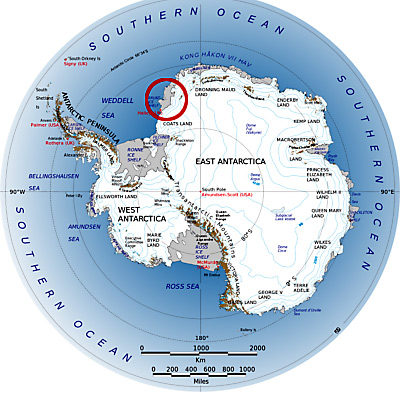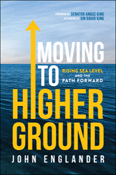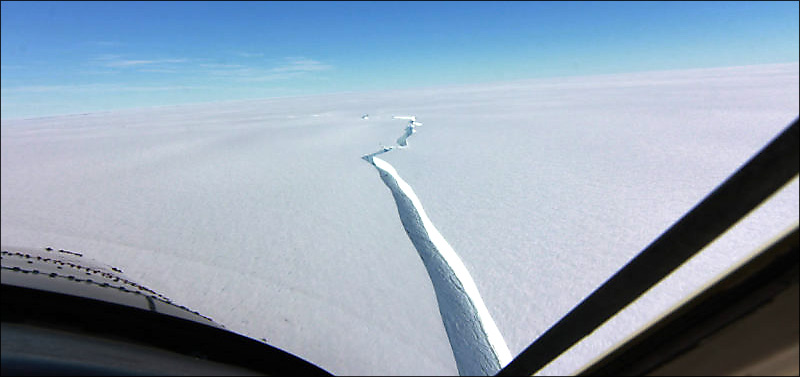Melting Icebergs & Sea Level. Yes? No?
A gigantic piece of ice broke off of Antarctica in late February, making international news.
The new iceberg, designated “A-74” and larger than the city of Los Angeles, is now adrift and will melt as it encounters warmer water.
There’s considerable confusion about whether events like this affect sea level rise. So, to get started, please answer this simple question:
Will the melting of iceberg A-74 affect sea level? Yes? No?
 To be clear, A-74 broke off from an even larger body of ice called the Brunt Ice Shelf, circled in red.
To be clear, A-74 broke off from an even larger body of ice called the Brunt Ice Shelf, circled in red.
Ice shelves are often massive, and the visible portion can be more than a hundred feet (30 meters) above the waterline. But do they increase sea level when they melt?
If you answered “No”, you are correct. Ice shelves, by definition, are freshwater ice that has flowed into the sea and floats there, still attached to ice on land but suspended in water.
Like an ice cube floating in a glass of water, the water level will not be affected as the ice shelf, or any part of it, melts. Iceberg A-74 did not have any effect on sea level when it separated from the ice shelf, and it will not have any effect as it melts.
If you answered “Yes”, you are partly correct, but the timing is a bit off. When the Brunt Ice Self first moved from land to the ocean, it did increase sea level but that was long ago.
Ice Sheets are giant masses of frozen water on top of land. Those that are moving, due to gravity, are glaciers, often described as slowly moving rivers of ice.
It is when glaciers flow from land to sea that sea level rises. The most dramatic form of land ice entering the sea is when an elevated piece of glacier or ice sheet on land breaks off and falls into the sea with a thunderous splash, called “calving.”
While calving is dramatic, in today’s rapidly warming planet, it is the fresh water “rivers” of meltwater from Antarctica & Greenland that find their way to the sea that are responsible for most of sea level rise. Until the planet cools, melting will accelerate and continue for centuries.
Events like the creation of A-74 are extremely important, however, as ice shelves DO prevent additional ice on land from flowing into the ocean. They are like the stopper in the bottle. When the stopper is removed, it allows ice on land to move more quickly into the sea. More ice on land into the water, the more sea level rise we get.
While it may seem distant and irrelevant, there’s enough ice on Antarctica and Greenland to raise global sea level more than two hundred feet (60 meters). How much will melt? How much will the sea rise? How we deal with greenhouse gases and global warming will ultimately determine that answer, but the amount of heat already stored in the ocean (we have no way to get it out) guarantees rising seas for centuries – ultimately the longest lasting effect of climate change.
Anyone wanting to learn more about the difference between ice sheets, glaciers, ice shelves, icebergs, and floating sea ice will find descriptions in my new book, Moving to Higher Ground: Rising Sea Level and the Path Forward.
Publication date is exactly four weeks away, April 6. Needless to say I am excited — even a bit anxious. This is my second book. Though I was very pleased with the first, High Tide on Main Street, If you believe, as I do, that dramatic action on climate change needs to be taken NOW, please consider becoming a Climate Ambassador… Costs nothing but a little time…
Looking for a Few “Climate Ambassadors”…

My new book will be available on April 6, 2021 in all formats: hard cover, soft cover, audio, and e-book. Early orders are already coming in on Amazon, Barnes & Noble, and around the world of books.
The publisher (The Science Bookshelf) and I are looking for volunteers to help spread the word about climate change and sea level rise via social media and other out-reach mechanisms (web sites, newsletters, etc.). We want to spread the word about the dramatic need for positive action on climate change.
We will send you social media graphics that you may include (or not) in your social media posts.
Climate ambassadors can have a profound impact on the number of people our message reaches. If you are interested in helping, please send an email to: ambassador@thesciencebookshelf.com
We will send you a reply and include the first three chapters of my new book in PDF form to introduce you to the material and approach of the book (apolitical, general audience, not heavy science).
If you have additional ideas for helping to get the climate change and sea level rise message out to the general public, please feel free to get in touch with Bill Gleason, publisher of The Science Bookshelf, at billg@thesciencebookshelf.com

